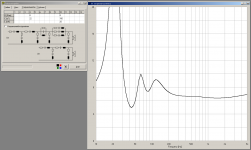Michael:
It was reflections that manage to get into the port.
I was thinking one could have a slanted brace that reflects some sound to the top of the enclosure, as well as some 3cm wool felt on strategic places.
Aha... an angled plate directing the sound coming from the driver upwards to the top of the box. From there it may be reflected back to the bottom, where the port is, but it's quite a distance (about 1.5 x the internal height of the box), so the damping (wool or whatever) should take care of the mid-frequency garbage. Sounds like something to try!
Yes, I think it might work. Maybe use two boards at even spacing, one behind the woofer, the other behind the mid, slanted upwards like / and clad in wool felt, probably no more need of damping material.
I know the mid is closed. That is insignificant, it is to help break up and eliminate internal modes, has nothing to do with the mid.
Yes it is about the LCR in the bass section.
To realize a smooth SPL response an LCR with this bandwidh is needed.
It is not possible with a smaller bandwith, then you get big ripple on the SPL, because the impedance is not flat anymore...
The lowest impedance peak is attenuated but not compensated.
The LCR is designed to compensate the highest impedance peak completely. It is optimized looking to the SPL mapping on the low frequency target.
The SPL is very sensitive to LCR value variation also. Again an argument to make the Q of the basreflex not too high.
Here's my attempt on the impedance peak compensation. The minimum is 5 Ohm at about 42 Hz (this is with the D.A.S. driver in a 65L box). Add a bit of series resistance for the series inductors and the dip will end up being slightly higher than 5 Ohm. Still not great, but there is hope.
Attachments
Once the final woofer, basreflex and X-over concept are defined, we will solve it for sure. A minimum impedance of 5 Ohm is possible and adding some serial resistance even more.
I am going to let it rest now for a while.
I am going to let it rest now for a while.
Some simulated plots for an overview of the Monkey Box with a LR4 filter at 500 and 2500 Hz.
Drivers are Faital Pro 12PR320, Volt VM752 and Satori TW29BN.
Woofer in a 80 L basreflex enclosure tuned at 35 Hz
Simulation is based on the driver data sheets.
In attach:
- Schematic X-over
- SPL vs. Freq on axis @ 1m, 2.83Vrms
- Power vs. Freq @ 3m, 2.83 Vrms
- Total Impedance
- Total group delay
- Excursion of the drivers at maximum SPL
- Amplifier power and power dissipated by the drivers at maximum SPL
- Horizontal off axis SPL 15 30 45 60 75 90 deg normalized to on axis SPL
- Horizontal polar diagrams above 1 kHz
- Vertical polar diagrams above 1 kHz
Some remarks:
- Maximum SPL at maximum excursion of the woofer is 110.6 DB @ 1m, 27 Vrms on the input.
- Minimum impedance is 4.65 Ohm using a 0.1 E serial resistance for each filter coil of the woofer filter. It can be improved by increasing the total serial resistance a little.
- At maximum excursion of the woofer at 59 Hz, the midrange excursion is maximum 409 um at 395 Hz and the tweeter excursion is maximum 91.8 um at 2460 Hz. Below 31 Hz the woofer excursion becomes higher.
- The horizontal off axis response is the best on the right side of the speaker if the midrange and the tweeter are positioned at the left side. The difference is low.
- Impact of internal cabinet resonances not included in this study
As a conclusion of this study, Monkey box with this concept is a feasible design. Choosing other woofer or tweeter with comparable characteristics will not change a lot.
Other X-over filter types will have comparable responses in the driver passbands.
Edit: The current horizontal off axis SPL simulations are done with the actual Volt VM752 Leap model without waveguide.
With waveguide the off axis responses will be different, but not that much. Now it will give already a first idea. See also post #88.
Drivers are Faital Pro 12PR320, Volt VM752 and Satori TW29BN.
Woofer in a 80 L basreflex enclosure tuned at 35 Hz
Simulation is based on the driver data sheets.
In attach:
- Schematic X-over
- SPL vs. Freq on axis @ 1m, 2.83Vrms
- Power vs. Freq @ 3m, 2.83 Vrms
- Total Impedance
- Total group delay
- Excursion of the drivers at maximum SPL
- Amplifier power and power dissipated by the drivers at maximum SPL
- Horizontal off axis SPL 15 30 45 60 75 90 deg normalized to on axis SPL
- Horizontal polar diagrams above 1 kHz
- Vertical polar diagrams above 1 kHz
Some remarks:
- Maximum SPL at maximum excursion of the woofer is 110.6 DB @ 1m, 27 Vrms on the input.
- Minimum impedance is 4.65 Ohm using a 0.1 E serial resistance for each filter coil of the woofer filter. It can be improved by increasing the total serial resistance a little.
- At maximum excursion of the woofer at 59 Hz, the midrange excursion is maximum 409 um at 395 Hz and the tweeter excursion is maximum 91.8 um at 2460 Hz. Below 31 Hz the woofer excursion becomes higher.
- The horizontal off axis response is the best on the right side of the speaker if the midrange and the tweeter are positioned at the left side. The difference is low.
- Impact of internal cabinet resonances not included in this study
As a conclusion of this study, Monkey box with this concept is a feasible design. Choosing other woofer or tweeter with comparable characteristics will not change a lot.
Other X-over filter types will have comparable responses in the driver passbands.
Edit: The current horizontal off axis SPL simulations are done with the actual Volt VM752 Leap model without waveguide.
With waveguide the off axis responses will be different, but not that much. Now it will give already a first idea. See also post #88.
Attachments
-
 Polar Horizontal above 1 kHz Monkey Box LR4.JPG193.6 KB · Views: 167
Polar Horizontal above 1 kHz Monkey Box LR4.JPG193.6 KB · Views: 167 -
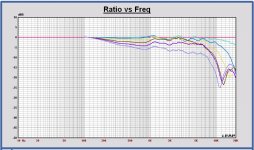 Horizontal off axis 15 30 45 60 75 90 normalized to 0 deg Monkey Box LR4.JPG155.3 KB · Views: 149
Horizontal off axis 15 30 45 60 75 90 normalized to 0 deg Monkey Box LR4.JPG155.3 KB · Views: 149 -
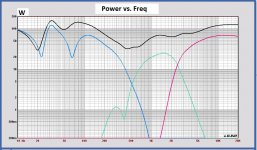 Amplifier and driver power at max SPL Monkey Box LR4.JPG158.8 KB · Views: 143
Amplifier and driver power at max SPL Monkey Box LR4.JPG158.8 KB · Views: 143 -
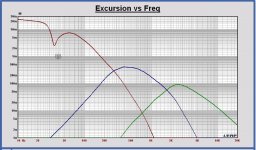 Excursion at maximum SPL Monkey Box LR4.JPG155 KB · Views: 143
Excursion at maximum SPL Monkey Box LR4.JPG155 KB · Views: 143 -
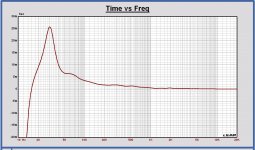 Total group delay Monkey Box LR4.JPG207.4 KB · Views: 146
Total group delay Monkey Box LR4.JPG207.4 KB · Views: 146 -
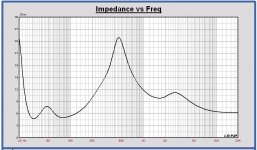 Impedance Monkey Box LR4.JPG114.1 KB · Views: 420
Impedance Monkey Box LR4.JPG114.1 KB · Views: 420 -
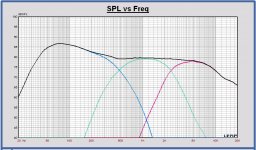 Power 2.83 Vrms at 3m Monkey Box LR4.JPG144.8 KB · Views: 432
Power 2.83 Vrms at 3m Monkey Box LR4.JPG144.8 KB · Views: 432 -
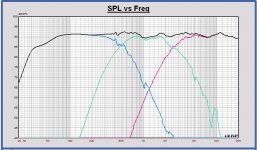 SPL on axis 2.83 Vrms 1m Monkey Box LR4.JPG145.7 KB · Views: 449
SPL on axis 2.83 Vrms 1m Monkey Box LR4.JPG145.7 KB · Views: 449 -
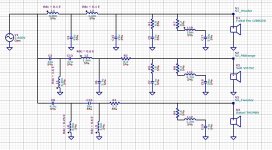 Schematic X-over Monkey Box LR4.JPG219.5 KB · Views: 433
Schematic X-over Monkey Box LR4.JPG219.5 KB · Views: 433 -
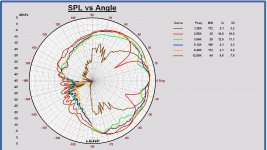 Polar Vertical above 1 kHz Monkey Box LR4.JPG198.8 KB · Views: 163
Polar Vertical above 1 kHz Monkey Box LR4.JPG198.8 KB · Views: 163
Last edited:
Good stuff!
I'd like to think about the first steps of building a prototype:
Some suggested tests and measurements (I am sure there are more ideas):
I could buy the drivers; but I would ask everyone for some sponsoring to pay the wood, x-over parts, and other bits and pieces. How about a total of CHF 400 sponsoring to my PayPal account to get me started?
I'd like to think about the first steps of building a prototype:
- I'd suggest to start building + testing the woofer + mid part first. We have not discussed the tweeter very much until now.
- Which woofer? D.A.S. 12P or the Faital 12PR320? I'd prefer the D.A.S. for its higher Qms, although it has slightly lower Xmax than the Faital.
- We might think a bit more about the box and tuning. Do we really need an 80 L box, or can we go a bit smaller?
- Where to put the port? Dimensions of the port?
Some suggested tests and measurements (I am sure there are more ideas):
- Naked drivers: impedance curves to check the TSP parameters and to optimise the impedance compensation in the x-over.
- Woofer in box: impedance curves to validate the bass tuning and to check for internal resonances.
- Woofer and port, acoustic nearfield: test box tuning
- Woofer and mid, acoustic farfield, gated/anechoic, different angles: determine SPL responses without and with x-over filters to check and optimize filters, to determine baffle/diffraction effects, and dispersion.
- Woofer, in room: determine room gain at low frequencies (how "bad" is the baffle step?)
I could buy the drivers; but I would ask everyone for some sponsoring to pay the wood, x-over parts, and other bits and pieces. How about a total of CHF 400 sponsoring to my PayPal account to get me started?
My reservation with the D.A.S. woofer is that they are an unknown. I've never seen anyone use them and you have to buy from a source I'm unfamiliar with. The Faital has a good reputation is available from very good distributors with a proven track record.
My reservation with the D.A.S. woofer is that they are an unknown. I've never seen anyone use them and you have to buy from a source I'm unfamiliar with. The Faital has a good reputation is available from very good distributors with a proven track record.
And they just sound so darn good!
My reservation with the D.A.S. woofer is that they are an unknown. I've never seen anyone use them and you have to buy from a source I'm unfamiliar with. The Faital has a good reputation is available from very good distributors with a proven track record.
Have you worked with Faital drivers before? To me, both are equally unknown.
Does anyone have experience with the typical accuracy of the the Faital or D.A.S. data sheets? I have been fooled by poor accuracy of the manufacturer specs before, and I like to stay away from such surprise bags.
And they just sound so darn good!
The Faital or the DAS? Have you heard these drivers? Please let us know what your experience is.
I also had a quick play with my AJ Horn simulations to look at the impedance dip around the tuning frequency. I could get the D.A.S. dip to 5 Ohm, whereas it was about 4.2 Ohm with the Faital (just with an LCR parallel to the driver, no other filter components).
Comparing these two drivers on their technical aspects, the three major differences are:
- Qms of the D.A.S.is higher: 10.1 versus 7.8, little advantage for the D.A.S.
- Xmax of the Faital is higher: 7.34 versus 6 mm, little advantage for the Faital
- Re of D.A.S. is larger: 6.5 versus 5.3 Ohm, which makes it more easy to keep the minimum impedance higher around the tuning frequency for the D.A.S.. The Faital needs more serial resistance in the filter for the same minimum impedance, with a little lower system SPL as a consequence, about 1dB.
The technical performance of both drivers is acceptable for this project, maybe it is more important to look to price and deliverabilty to make the best choice.
- Qms of the D.A.S.is higher: 10.1 versus 7.8, little advantage for the D.A.S.
- Xmax of the Faital is higher: 7.34 versus 6 mm, little advantage for the Faital
- Re of D.A.S. is larger: 6.5 versus 5.3 Ohm, which makes it more easy to keep the minimum impedance higher around the tuning frequency for the D.A.S.. The Faital needs more serial resistance in the filter for the same minimum impedance, with a little lower system SPL as a consequence, about 1dB.
The technical performance of both drivers is acceptable for this project, maybe it is more important to look to price and deliverabilty to make the best choice.
Last edited:
I'd guess the Xmax becomes relevant only if the box is driven by 100 W or more. Since the motivation to develop the Monkey Coffin is largely based on compatibility with "weak amps" I don't think that Xmax should have highest priority. But we're discussing based on the numbers given in the manufacturer datasheets only (and they are not always accurate). It would be best to test and compare the drivers ourselves.
Just because it's above average efficiency doen't mean it's going to be used with small amps.I'd guess the Xmax becomes relevant only if the box is driven by 100 W or more. Since the motivation to develop the Monkey Coffin is largely based on compatibility with "weak amps" I don't think that Xmax should have highest priority.
The Faitals are accurate. In fact I don't recall measuring a driver from a reputable manufacturer that was off by a large margin.But we're discussing based on the numbers given in the manufacturer datasheets only (and they are not always accurate).
My vote goes to the Faital because of availability alone. The DAS looks like a really nice driver, the difference should be small enough in real life that people should be able to choose freely. But the prototype should be built with the Faital.
Another vote for the Faital, based solely on having always heard good things about Faital drivers (anectodally), and having never heard of DAS. My subjective 2 cents.
My vote goes to the Faital because of availability alone.
I can't find a place in Switzerland where I could buy the Faital. I sent an email to Faital for a quote and distributor information, but they did not respond. Any recommendations on where to get the Faital 12PR320?
eventtechnik3000.ch is selling Faital components. But you have to compare the pricing. I once ordered Faital drivers form Parts Express at a better price than from anyone in Switzerland or a neighbouring country.
Regards
Charles
Regards
Charles
I could buy the drivers; but I would ask everyone for some sponsoring to pay the wood, x-over parts, and other bits and pieces. How about a total of CHF 400 sponsoring to my PayPal account to get me started?
I guess my PayPal account is not very transparent to everyone else, so I started a gofoundme campaign. If you want me to move ahead with building a first prototype for testing purposes, please support the campaign here. I you want to be included in the list of sponsors, please state your diyAudio user name in the comments of your donation.
For those of you who are actively participating in the design process or those who are interested in helping with fund raising, please send me a PM with your email address so that I can add you to the "team" of the gofundme campaign.
For those of you who are more into social media than me (i.e., most of you), please share the gofundme campaign so the project gets a bit more exposure in the right places.
Let's see how this goes.
P.S.: I guess I'll get both the Faital and the D.A.S. woofer so that we can compare them better.
Last edited:
- Home
- Loudspeakers
- Multi-Way
- Open Source Monkey Box
